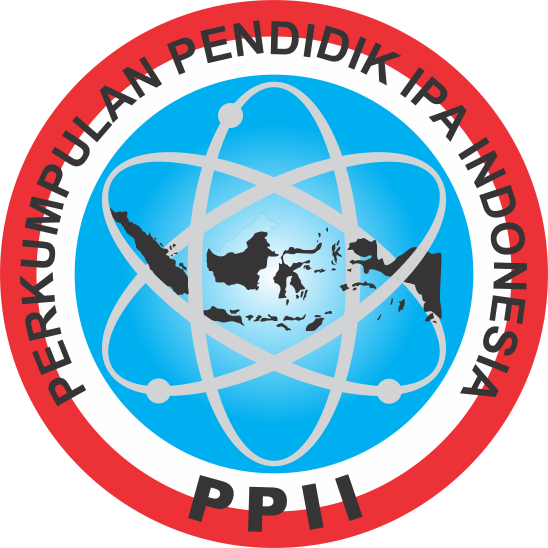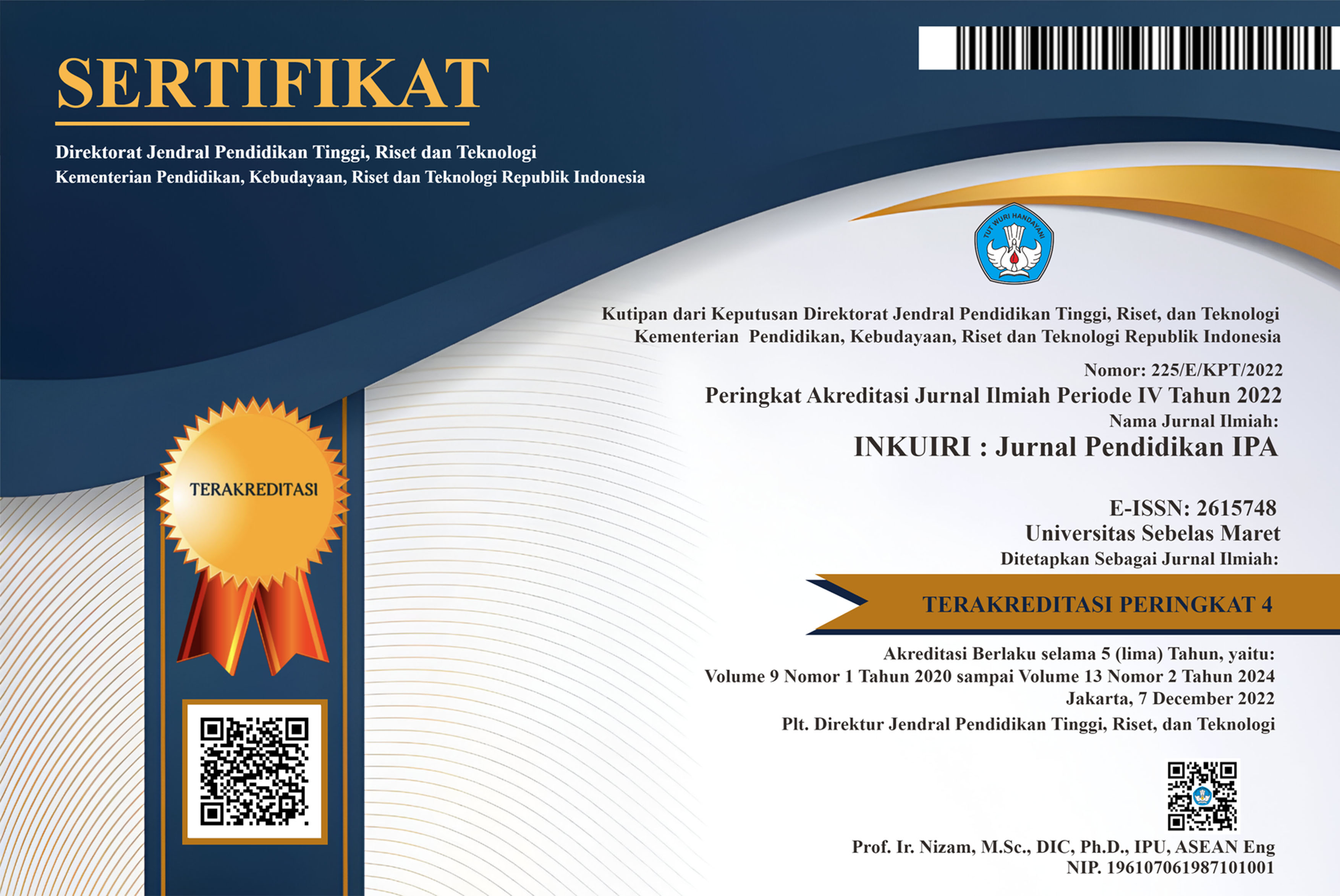PENGEMBANGAN MEDIA PEMBELAJARAN IPA POKOK BAHASAN MATA MANUSIA BERBASIS ANDROID
Abstract
Studi lapangan dan literatur merekomendasikan bahwa dibutuhkan media pembelajaran pokok bahasan mata manusia yang menyajikan tujuan pembelajaran, materi, evaluasi dan penilaiannya, serta mendukung terjadinya proses pembelajaran mandiri, interaktif, dan menyenangkan. Metode penelitian pengembangan ini menggunakan langkah-langkah: potensi dan masalah, pengumpulan data, desain produk, validasi desain, revisi desain, uji coba produk, revisi produk, uji coba pemakaian, revisi produk, dan produksi masal. Produk penelitian ini adalah aplikasi android ”Alat Optik Mata Manusia”. Karakteristik produk ini adalah: (1) memuat tujuan pembelajaran, materi, simulasi, latihan soal, dan evaluasi; (2) menu materi memuat: bagian-bagian mata, proses melihat, dan gangguan mata; (3) terdapat lima submenu simulasi yang interaktif dan komunikatif; (4) materi diuraikan melalui teks dan gambar full color; (5) terdapat evaluasi dengan penilaiannya; (6) dapat digunakan secara mandiri dan dapat mengulang-ulang materi yang diinginkan; dan (7) dapat digunakan dimanapun dan kapanpun. Kriteria kelayakan produk adalah ”sangat baik” dengan nilai 4,60; kriteria kepraktisan ”sangat baik” dengan nilai 4,51; dan kriteria keefektivan ”tinggi” dengan n-gain 0,76 sedangkan nilai rerata aktivitas siswa adalah 89,02 % dengan kriteria ”sangat baik”.
Field studies and literature recommend that learning media for the subject of the human eye is needed that presents learning objectives, materials, evaluations and assessments, and supports an independent, interactive, and fun learning process. This development research method uses the following steps: potential and problems, data collection, product design, design validation, design revision, product testing, product revision, usage testing, product revision, and mass production. The product of this research is the android application "Human Eye Optical Instrument". The characteristics of this product are: (1) contains learning objectives, materials, simulations, practice questions, and evaluations; (2) the material menu contains: parts of the eye, the process of seeing, and eye disorders; (3) there are five interactive and communicative simulation submenus; (4) the material is described through text and full color images; (5) there is an evaluation with the assessment; (6) can be used independently and can repeat the desired material; and (7) can be used anywhere and anytime. The product eligibility criteria are “very good” with a score of 4.60; practicality criteria “very good” with a score of 4.51; and the effectiveness criterion is "high" with an n-gain of 0.76 while the average value of student activity is 89.02% with the criteria of "very good".
Keywords
Full Text:
PDFReferences
bold'>ADDIN
Mendeley Bibliography CSL_BIBLIOGRAPHY Arista, F. S., & Kuswanto, H. (2018). Virtual physics laboratory application based on the android smartphone to improve learning independence and conceptual understanding. International Journal of Instruction, 11(1), 1–16.
Astra, I. M., Nasbey, H., & Nugraha, A. (2015). Development of an android application in the form of a simulation lab as learning media for senior high school students. Eurasia Journal of Mathematics, Science and Technology Education. https://doi.org/10.12973/eurasia.2015.1376a
Billah, A., & Widyatmoko, A. (2018). The Development of Virtual Laboratory Learning Media for The Physical Optics Subject. Jurnal Ilmiah Pendidikan Fisika Al-Biruni, 7(2), 153. https://doi.org/10.24042/jipfalbiruni.v7i2.2803
Liliarti, N., & Kuswanto, H. (2018). Improving the competence of diagrammatic and argumentative representation in physics through android-based mobile learning application. International Journal of Instruction, 11(3), 106–122.
Mardiana, N., & Kuswanto, H. (2017). Android-assisted physics mobile learning to improve senior high school students’ divergent thinking skills and physics HOTS. In 4th International Conference on Research, Implementation, and Education of Mathematics and Sciences: Research and Education for Developing Scientific Attitude in Sciences and Mathematics, ICRIEMS 2017 (Vol. 1868). American Institute of Physics Inc. https://doi.org/10.1063/1.4995181
Marzouki, O. F., Idrissi, M. K., & Bennani, S. (2017). Effects of Social Constructivist Mobile Learning Environments on Knowledge Acquisition: A Meta-Analysis. International Journal of Interactive Mobile Technologies. https://doi.org/10.3991/ijim.v11i1.5982
Qamariah, Jumadi, Senam, & Wilujeng, I. (2017). Validity of “hi-Science” as instructional media based-android refer to experiential learning model. In S. S., K. C., W. I., & A. A.M. (Eds.) (Vol. 1868). Graduate Stud. of Science Education, Yogyakarta State University, Indonesia: American Institute of Physics Inc. https://doi.org/10.1063/1.4995191
Said, K., Kurniawan, A., & Anton, O. (2018). Development of media-based learning using android mobile learning. Journal of Theoretical and Applied Information Technology, 96(3), 668–676. Retrieved from https://www.scopus.com/inward/record.uri?eid=2-s2.0-85042364571&partnerID=40&md5=ab615c63cd42ff403044ded0310c7731
Setiawan, A., Handojo, A., & Hadi, R. (2017). Indonesian Culture Learning Application Based on Android. International Journal of Electrical and Computer Engineering (IJECE). https://doi.org/10.11591/ijece.v7i1.pp526-535
Sugiyono. (2016). Metode Penelitian Kuantitatif, Kualitatif Dan R&D. Bandung: Alfabeta. https://doi.org/10.1017/CBO9781107415324.004
Ulfa, A. M., Sugiyarto, K. H., & Ikhsan, J. (2017). The effect of the use of android-based application in learning together to improve students’ academic performance. In AIP Conference Proceedings. https://doi.org/10.1063/1.4983910
Widyastuti, R., Soegiyanto, H., & Yusup, Y. (2018). The Development of Geo Smart Based Android for Geography Learning Media on Hydrosphere Material and Its Impact towards Life on Earth. In 1st UPI International Geography Seminar 2017, IGEOS 2017 (Vol. 145). Institute of Physics Publishing. https://doi.org/10.1088/1755-1315/145/1/012001
%;font-family:"Times New Roman",serif;mso-fareast-font-family:Calibri;
mso-ansi-language:EN-US;mso-fareast-language:EN-US;mso-bidi-language:AR-SA;
mso-bidi-font-weight:bold'>
Refbacks
- There are currently no refbacks.






